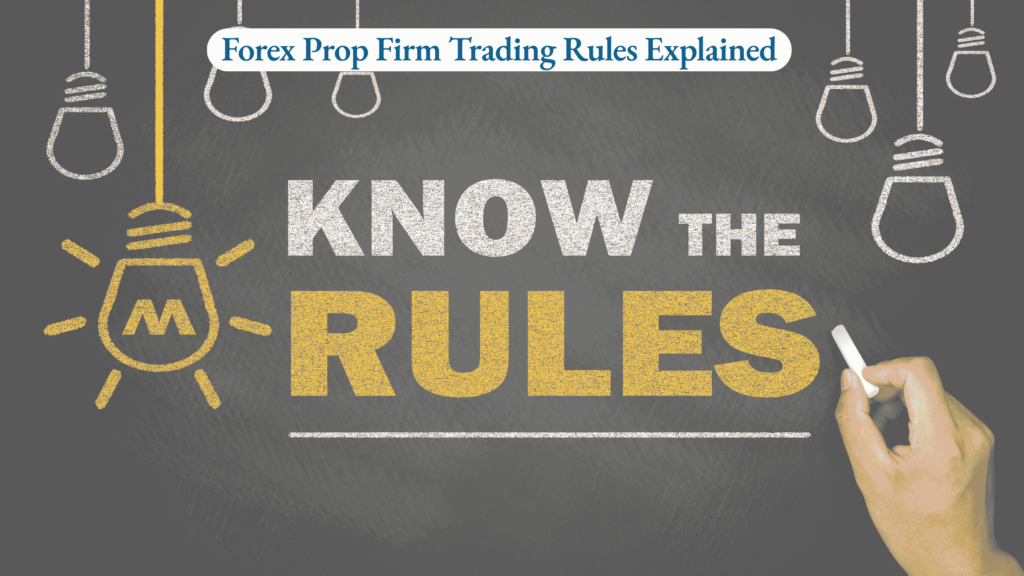Physical Address
304 North Cardinal St.
Dorchester Center, MA 02124

Did you know that over 80% of funded traders fail their prop firm challenges due to rule violations rather than poor trading performance? I recently analyzed data from three major prop firms and found that rule violations, particularly drawdown breaches, account for nearly 65% of all failed challenges. Let’s dive deep into these critical rules with real-world examples that every aspiring prop trader needs to understand.
Absolute drawdown measures the maximum loss allowed from your initial account balance and typically ranges from 8-12% of your starting capital. Once this threshold is breached, your funded account is immediately terminated, making it one of the most critical rules to monitor during your trading journey.
Consider a $100,000 funded account with a 10% absolute drawdown limit. This means your account can never drop below $90,000, regardless of any winning trades in between. For example, if you start at $100,000, grow it to $150,000, and then experience losses, you’ll still be terminated if your balance falls to $89,999 – even though you’re technically still profitable overall. This rule protects the prop firm’s capital by establishing a clear line in the sand for maximum loss tolerance.
Daily drawdown limits track your losses within a single trading day, usually set between 4-5% of your account balance. This rule resets at the start of each trading day and includes both closed and open positions, forcing traders to implement strict intraday risk management protocols.
With a 5% daily drawdown limit on a $100,000 account, you can’t lose more than $5,000 in a single trading day. Here’s where it gets interesting: if you’re down $4,800 for the day and have an open position showing -$300 in floating loss, you’re actually in violation territory since most firms calculate daily drawdown based on equity ($4,800 + $300 = $5,100). This dynamic aspect of daily drawdown catches many traders off guard, especially during volatile market conditions.
Balance-based drawdown focuses exclusively on closed positions and realized losses, making it particularly relevant for swing traders. Most prop firms set this limit between 5-8% of the account size, providing a clear boundary for realized losses across your trading activities.
Let’s say you have a $100,000 account with an 8% balance-based drawdown limit ($8,000). You could lose $2,000 on Monday, make back $1,500 on Tuesday, lose another $3,000 on Wednesday, and you’re still within limits because your total realized loss from the starting balance is $3,500. However, one more significant losing trade could trigger a violation. Traders often prefer this rule because it offers more flexibility for recovering from losses.
Equity-based drawdown includes both realized and unrealized losses, making it the most stringent drawdown rule. Most trading firms implement this rule to prevent traders from holding losing positions indefinitely, typically setting limits between 5-10% of the account size.
Using the same $100,000 account with a 10% equity-based drawdown: if you’re holding five open positions each showing -$1,500 in floating losses (-$7,500 total), you only have $2,500 of remaining drawdown cushion for any new trades or further adverse market movements. This rule effectively prevents traders from “holding and hoping” with losing positions.
Prop firms establish minimum profit targets to ensure traders demonstrate consistent profitability rather than just avoiding losses. Most firms require traders to achieve a profit target between 8-12% during the evaluation phase, while maintaining these targets becomes more manageable in the live funded account phase. The trading time allowed to reach these targets varies significantly between firms, with some allowing as little as 5 days while others extend the period to 60 days.
Many forex prop firms implement strict rules regarding holding positions overnight or over weekends due to increased exposure to gap risks and volatile market opens. Weekend holds are particularly scrutinized because significant news events or geopolitical developments can cause substantial gaps when markets reopen. Some firms completely prohibit overnight holding, while others may allow it with reduced position sizes or additional margin requirements.
Consider the Swiss Franc event of 2015, where the EUR/CHF dropped over 30% in minutes. Traders holding positions overnight during such events can face catastrophic losses. This explains why many prop firms either prohibit overnight holding or require reduced position sizes.
For example, a firm might allow standard lot sizes of 5.0 during regular trading but require reduction to 2.0 maximum for overnight positions. Weekend holds are even more restricted – some firms require position sizes to be reduced to 0.5 lots maximum or completely closed by Friday evening.
The stance on EAs varies dramatically between firms. Let’s say you have a profitable EA that averages 5% monthly returns with a maximum drawdown of 15%. Even with these solid metrics, many prop firms will reject it because the drawdown exceeds their risk parameters. Firms that do accept EAs typically require extensive documentation including at least 6 months of verified backtest results and live trading history, with maximum drawdown not exceeding 5% in any given month.

Prop trading firms typically enforce maximum lot size restrictions based on account size to prevent excessive risk-taking. These limits often scale with account size and trading performance, usually starting at 1-2% of account equity per trade and potentially increasing for consistently profitable traders.
On a $100,000 account, prop firms typically restrict lot sizes to 1-3% of account equity per trade. This translates to about 10 standard lots maximum per trade on major pairs. For correlated pairs, this limit is often reduced. For example, if you’re trading both EUR/USD and EUR/JPY, your combined exposure might be limited to 12 standard lots total rather than 10 lots each.
Most forex prop firms mandate the use of stop-loss orders on all positions to prevent catastrophic losses. While specific distance requirements vary between firms, the standard practice enforces stop-loss placement within 1-2% of entry prices. Some firms even automatically reject trades submitted without proper stop-loss orders.
On a standard lot EUR/USD position at 1.1000, this means your stop loss must be within 10-20 pips of your entry. Some firms implement automatic stop losses if a trader’s position moves against them beyond a certain threshold – typically 3-5% of account equity – to prevent emotional decision-making during drawdown periods.
To promote sustainable trading practices, many prop firms implement minimum risk-to-reward ratios for trades. Traders are typically required to maintain at least a 1:1 risk-to-reward ratio, with some firms preferring more conservative 1:2 or 1:3 ratios to ensure long-term profitability.
With a mandatory 1:2 risk-to-reward ratio on a $100,000 account risking 1% per trade ($1,000), your take profit must be set to capture at least $2,000 in profit. This rule prevents traders from taking numerous small winners that can be wiped out by a single loss, promoting more sustainable trading practices.
Proprietary trading firms enforce key rules including drawdown limits, profit targets, and minimum trading days requirements. Most trading firms lack an explanation of hidden rules on their websites, but these typically include restrictions on trading styles, position holding periods, and risk management protocols. The rules are designed to protect firm capital while allowing traders to demonstrate consistent trading ability.
Forex prop trading firms provide traders access to large trading capital after passing evaluation challenges that test their trading abilities. Traders must follow the prop firm’s rules including drawdown limits, profit targets, and consistent trading during the minimum trading period. Once funded, traders typically keep 70-85% of profits while trading funded accounts.
Funding Traders offers a 1-Step Challenge with 5% trailing drawdown and 4% daily drawdown limits. Their 2-Step Challenge implements a more generous 10% static drawdown limit during the evaluation phase. These drawdown limit rules are designed to protect proprietary trading firm capital while allowing reasonable trading flexibility.
Most prop firms require traders to prove their abilities before accessing funded accounts ranging from $25,000 to $200,000. With consistent trading and proper risk management, traders typically earn 5-15% monthly on their prop trading account, keeping 70-85% of profits. Top performers can scale to managing several million in proprietary trading firm capital through demonstration of reliable results.
Understanding these rules with concrete numbers and examples reveals why prop firms implement them and how to trade within their boundaries successfully. Before starting your funded trader journey, consider paper trading with these exact rules for at least a month. Remember, prop trading success isn’t just about profitable strategies – it’s about mastering these rules while maintaining consistent profitability.
Check out our latest blog Are Prop Firms Legit?